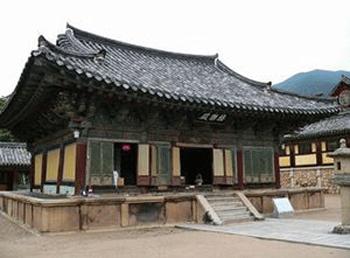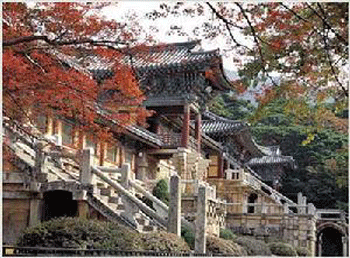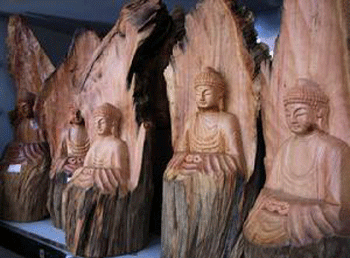
Bulguksa is a head temple of the Jogye Order of Korean Buddhism in the North Gyeongsang province in South Korea. It is home to seven National treasures of South Korea, including Dabotap and Seokgatap stone pagodas, Cheongun-gyo (Blue Cloud Bridge), and two gilt-bronze statues of Buddha. The temple is classified as Historic and Scenic Site No. 1 by the South Korean government. In 1995, Bulguksa was added to the UNESCO World Heritage List together with the Seokguram Grotto, which lies four kilometers to the east.
The temple is considered as a masterpiece of the golden age of Buddhist art in the Silla kingdom. It is currently the head temple of the 11th district of the Jogye Order of Korean Buddhism.

The temple’s records state that a small temple was built on this site under King Beopheung in 528. The Samguk Yusa records that the current temple was constructed under King Gyeongdeok in 751, begun by Prime Minister Kim Daeseong to pacify the spirits of his parents. The building was completed in 774 by the Silla royal court, after Gim’s death, and given its current name Bulguksa (Temple of the Buddha Land).
The temple was renovated during the Goryeo Dynasty and the early Joseon Dynasty. During the Japanese invasions between 1592 and 1598, the wooden buildings were burned to the ground. After 1604, reconstruction and expansion of Bulguksa started, followed by about 40 renovations until 1805. During the Japanese occupation of 1910-1945, the Japanese conducted a restoration, but there are no records of the work done, and known treasures disappeared during this time.
After World War II and the Korean War, a partial restoration was conducted in 1966. Upon an extensive archeological investigation, major restoration was conducted between 1969 and 1973 by the order of President Park Chung Hee, bringing Bulguksa to its current form. The famous stone structures are preserved from the original Silla construction.

The temple is located on the slopes of Tohamsan, in Jinheon-dong, Gyeongju.
The entrance to the temple, Sokgyemun, has a double-sectioned staircase and bridge that leads to the inside of the temple compound. The stairway is 33 steps high, corresponding to the 33 steps to enlightenment. The lower portion, Cheongungyo (Blue Cloud Bridge) is 6.3 meters long and has 17 steps. The upper portion, Baegungyo (White Cloud Bridge) is 5.4 meters and has 16 steps. The stairway leads to Jahamun (Mauve Mist Gate).
There are two pagodas on the temple site, which is unusual. The three-story Seokgatap (Sakyamuni Pagoda) which stands at 8.2 meters is a traditional Korean-style stone pagoda with simple lines and minimal detailing. Seokgatap is over 13 centuries old. Dabotap (Many Treasure Pagoda) is 10.4 meters tall and dedicated to the Many Treasures Buddha mentioned in the Lotus Sutra. In contrast to Seokgatap, Dabotap is known for its highly ornate structure. Its image is reproduced on the South Korean 10 won coin. Dabotap and Seokgatap are Korean National Treasures nos. 20 and 21, respectively.
The terrestrial and the two celestial abodes are manifested in Bulguksa: the terrestrial with a Shakyamuni Buddha Lotus Sutra, the celestial with Amitabha Buddha Avatamska Sutra. The large temple site is centred around two courts. One of the courts is centred on Daeungjeon, the hall which houses the Shakyamuni Buddha. The other is centred on Geungnakjeon, the hall of paradise where the Seven Treasure Bridge Chilbogyo is housed.
Daeungjeon, the Hall of Great Enlightenment, is the main hall. Dabotap and Seokgatap stand before this hall. The hall enshrines the Sakyamuni Buddha and was built in 681 CE. Behind the main hall stands Museoljeon, the Hall of No Words. This hall gets its name from the belief that Buddha’s teachings could not be taught by mere words alone. It is one of the oldest buildings in the complex and was probably built in 670 CE. The Gwaneumjeon houses an image of the Avalokitesvara, the Bodhisattva of Perfect Compassion, and stands at the highest point of the complex. The Birojeon, which sits below the Gwaneumjeon, houses national treasure No.26 while the Geuknakjeon, standing near the main compound, houses the gilt-bronze buddha that is the national treasure No.27.
Tel: +82 (0) 746 9913
(From: Wikipedia)




